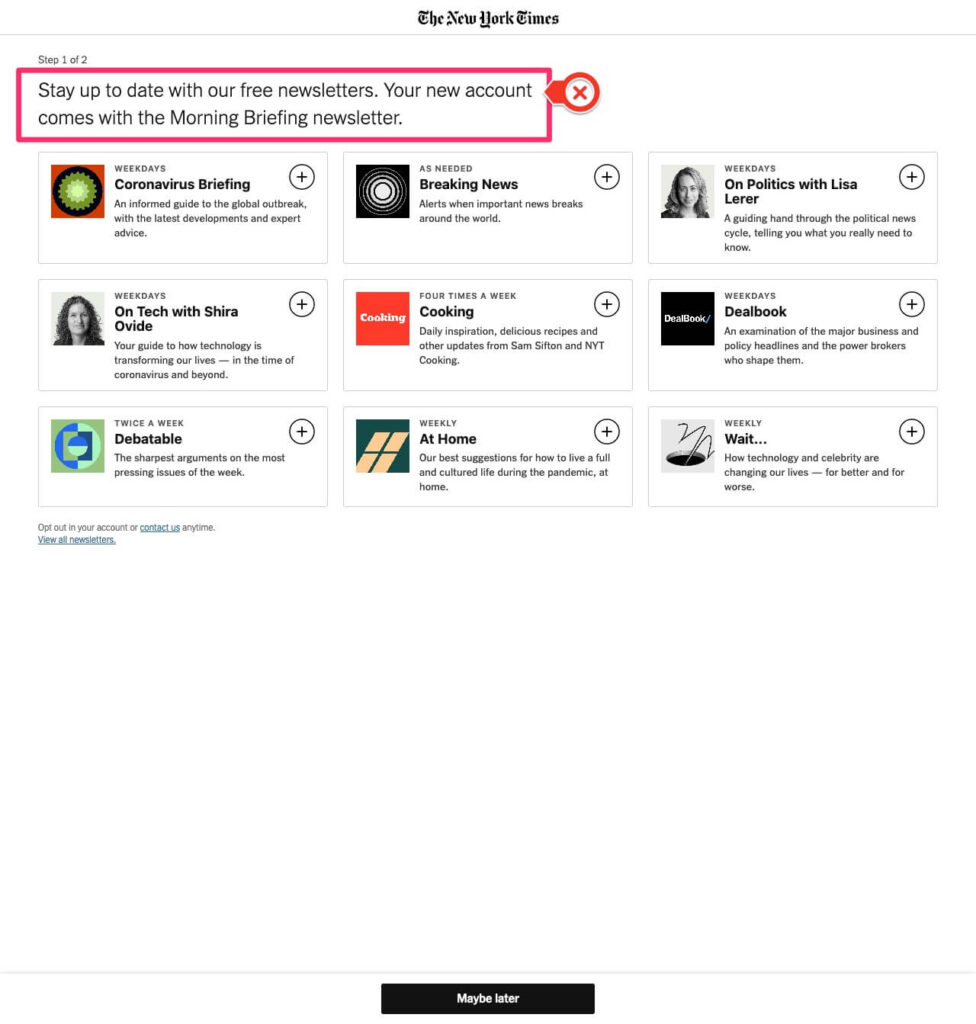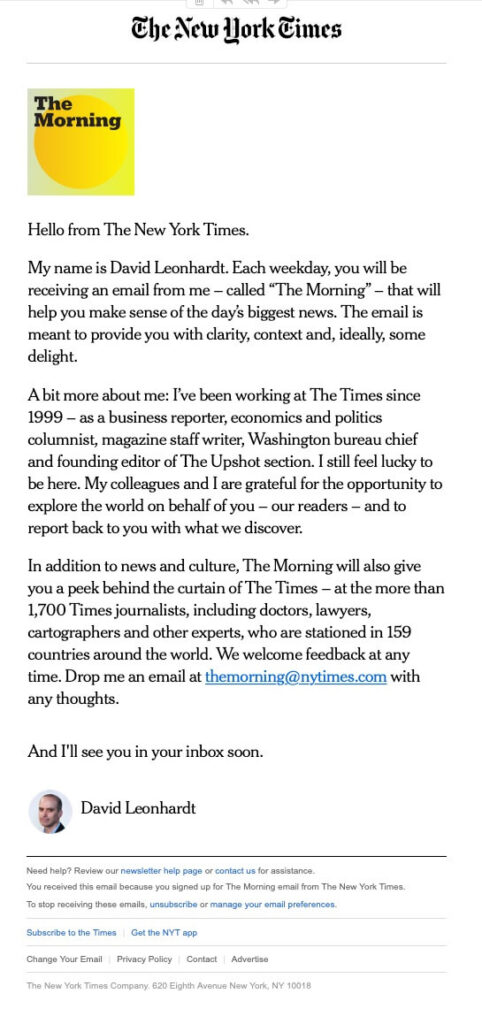How the New York Times used deceptive patterns and spam to reach 17 million newsletter subscribers (and counting)
Note: This post was originally published May 2020. The analysis and screenshots reflect that period in time, but may no longer reflect the current sign-up process.
The New York Times got a lot of buzz last week when it claimed a whopping 17 million subscribers to “The Morning.” The thing is? 17 million is a bullshit number because the Times subscribes people to its flagship newsletter without permission.
Note: The press release mentions that “Morning Briefing” is rebranded as “The Morning.” Below, I use “The Morning” unless it refers to a screenshot or copy that says otherwise.
Don’t believe every press release
For starters, let’s note that this number originated in a Times press release. From Facebook’s fraudulent video metrics to the carnival barker bullshit that is Hyperloop, any PR or marketing claim is automatically questionable.
And why is this particular marketing claim questionable?
Let’s look at some of the other big newsletters around. According to figures from Revue’s Mark Schiefelbein:
- TheSkimm: 3.5M to 9M subscribers from reports in 2016 and 2018.
- Morning Brew: 2M subscribers
- Axios: 1.5M across all newsletter
At first blush, it’s certainly possible the vaunted New York Times has a newsletter several factors larger than these companies. And besides, all three are much younger entrants to the newsletter landscape. But –
Without trying hard, I came across some other figures that made me question the Times’ claim of 17 million subscribers to a single newsletter. Those figures were from…the New York Times.
In July 2018, the very similarly named “U.S. Morning Briefing” had 1.6M subscribers. That’s a big audience! But it’s a long way from 17M. In this behind-the-scenes look at newsletters, the Times says its 55 newsletters total 14M subscribers. Again, that doesn’t seem unreasonable.
A few months later in November 2018, “Morning Briefing” launched a redesign. It had 1.7M subscribers. The Times also added a claim that “hundreds of thousands more read it on our website and apps.” That’s marketing fluff.
Getting to 17M from 1.6M in under two years is a big leap. Thankfully, Mark did the math for me: “Going from 1.6 million to 17 million in 21 months averages out to a 12% monthly growth rate, akin to adding something like 2 million subscribers per month currently.”
I appreciate Mark’s research, analysis, and math. But I was still feeling pretty skeptical about this whole thing. And by now, I’d heard that the uptick in subscriptions was tied to the free coronavirus coverage. So I dug deeper.
And when I dug deeper, I saw what was really going on. Deceptive design patterns. Dishonest practices. Spam.
Here’s what I mean:

The New York Times’ deceptive newsletter subscription process, step-by-step
Asking for an email address to access content is a reasonable request. Plenty of publishers incorporate registration walls into their business strategy. It’s not surprising The New York Times coronavirus page blocks access to the content until you create an account, although there’s an easy case to be made that pay walling public health information is gross.
Note: I only ran through this with an email account. I did not use the “Continue with Google”, “Continue with Facebook” or Continue with Apple” options.
A person adds their email, and clicks “Continue” to get past this particular wall.
On the next screen, you choose a password. There is also a box under the password field. It’s checked by default, and it says, “You agree to receive updates and offers from The Times. You may opt-out anytime.” Having an opt-in checked by default is a deceptive design pattern. It’s designed to trick people, which makes it a bad practice, but let’s talk about that in a minute. What’s happening here is even worse.

Having done that, a person clicks “Create Account” to move on.
The next screen is a subscription offer. Let’s click “Continue without subscribing” for now.

Here’s the first big problem. I didn’t even notice this at first.

We’ve all been through this type of page before. It’s a way to give people the option to grab some other newsletters as part of the registration process. I have no issue with asking for sign-ups.
The problem is the statement at the top: “Your new account comes with the Morning Briefing newsletter.”
I didn’t opt in for that. In fact, I specifically unchecked the box that says, “You agree to receive updates and offers from The Times.” I’ve already chosen not to receive updates. There is no way to unselect “Morning Briefing.”
This is spam. The New York Times is signing me up for newsletters I’ve already said I don’t want. There is no way to opt out.
Let’s say, like me, you missed this the first time around. Now you are continuing through this sign-up process, completely unaware that you are about to land on a mailing list that will invade your inbox every day, even when you click “Maybe later” at the bottom.
I get one more screen suggesting that I download the New York Times app, by sharing my phone number. Clicking “No, thanks. Take me back to reading” sends me back to the page where we started. I think I’m past the registration wall, thinking that I’m not going to get spammed.
Instead, within minutes of completing the above sequence, I got this:

For the cherry on top, check out this line in the footer:

“You received this email because you signed up for The Morning email from The New York Times.” [emphasis added]. I did no such thing. I had no choice in this subscription.
This kind of manipulative sign-up approach is referred to as a dark pattern. Best part? The Times has reported on these types of deceptive practices.
Dark patterns trick people into signing up for things they may not want
In 2019, Princeton researchers studying dark patterns found 20+ websites using “confusing messages when encouraging users to sign up for emails and other services.” [The New York Times link]
One typical dark pattern is “misdirection,” defined as “prominent marketing come-ons may distract users from seeing check boxes that by default, say, sign them up for a newsletter or membership,” in this 2016 New York Times story.
Perhaps the Times should turn the reporters of the 2016 story loose on themselves.
Okay, so what about those folks who do want to receive “updates and offers” from the Times? They also get signed up for “The Morning.” Of course, the Times doesn’t exactly do its level best to present this information in a clear fashion.
Here’s what the newsletter option page looks like after I created another account. This time I left the “updates and offers” box checked.

We have two opposing things going on here. First, there’s the same “Your new account comes with the Morning Briefing” copy. But look at the newsletter in the top right corner: “Morning Briefing.” It’s not selected.
So it seems that the Times forces readers to subscribe to “The Morning,” even when they don’t select any newsletters. And, if someone wants “Coronavirus Briefing” but not ”The Morning,” they can’t do that. The outcome here is the same as it is in the first example. The Times sends newly registered people “The Morning” without asking permission.
Further, inspection revealed these dark patterns and spam are not only on coronavirus pages. When I registered a new account on this page from 2019, I again received “The Morning” after opting out of email.
Hiding a daily newsletter behind “updates and offers” is another kind of bullshit, but it’s still bullshit. And here’s the thing: If you’re offering something worth having, you don’t need to hide it. At the very least, say “you agree to get The Morning” and let people decide. That’s not as good as an explicit opt-in, but it’s better than what’s there now.
This isn’t hard. Do right by your readers.
Digital journalism is an exciting place to try new things. But trying to short-cut the process by adopting the tech industry’s dirty tricks is not a path to success.
Let’s return to the fact that what started me down this particular rabbit hole was a press release; press releases are selling something. I wouldn’t take corporate marketing at face value from ExxonMobil or Volkswagen or Facebook. Why make an exception for The New York Times?
So what’s the Times selling?
The New York Times is selling itself as The Only News Brand That Matters (my deepest apologies to The Clash).
The Times press release describes The Morning’s 17 million subscribers as “one of the largest daily audiences of any kind in journalism, across television, radio, print and digital” [emphasis added].
The New York Times is easily the biggest success story for transitioning a print newspaper to digital products. It boasts 4 million digital-only news subscriptions and 5 million digital subscribers when you include Crossword & Cooking products. “The Daily” is arguably the most popular news podcast. The Times claims 2 million daily downloads.
These are undeniably impressive numbers. The closest newspaper competitor is the Wall Street Journal’s 2 million subscribers.
But this isn’t about newspapers. A daily audience of 17 million puts “The Morning” on par with the biggest media brands. April ratings showed coronavirus coverage pushing TV news viewership through the roof. “ABC World News Tonight with David Muir” averaged 12.36 million viewers a night through March & April. “NBC Nightly News with Lester Holt” averaged 10.66 million viewers. The most popular cable news show, “Special Report with Bret Baier” (Fox News), averaged 5.77 million viewers.
Of course, this isn’t apples-to-apples. Newsletters and television are very different. Putting aside that the Times is adding people without permission, 100% of subscribers aren’t opening this email every day. But this is marketing fluff. That’s why it’s in a press release.
This is a grab for a bigger slice of the news market. Striving for a bigger footprint in a down market is strategic. This approach clears a path for the Times to bring more people into their free products like “Morning Briefing” and “The Daily”, so they can work on converting them to paid subscribers
It’s what I would do. It’s what I counsel my clients that they should do, especially when you’re getting a surge of new readers. But I would never advise doing it like this.
Popularity is attractive to consumers. People love to jump on bandwagons. The most popular option often looks like the best option. When someone sees “17 million subscribers,” your brain assumes those subscribers love that product.
Local publishers should see this strategy as a warning. If the Times convinces enough people they are the default news subscription worth paying for, a lot of local newsrooms will be left scrambling over scraps.






